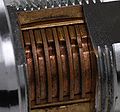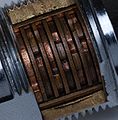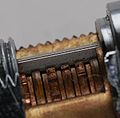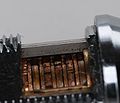Abloy Exec: Difference between revisions
JasonAller (talk | contribs) |
|||
| Line 10: | Line 10: | ||
|related = [[Abloy Classic]]<br>[[Abloy Profile]]<br>[[Abloy Disklock]]<br>[[Abloy Protec]] | |related = [[Abloy Classic]]<br>[[Abloy Profile]]<br>[[Abloy Disklock]]<br>[[Abloy Protec]] | ||
|patent = | |patent = | ||
} | |||
The '''Exec''' is a [[disc-detainer]] lock made by [[Abloy]]. The Exec uses between 9 and 11 discs that interface with a [[sidebar]]. It is a modified version of the [[Abloy Disklock]] that includes a Disk Steering System (DSS) designed to protect against [[lockpicking]]. Unlike the Disklock, the Exec only allows the key to be turned one direction. As such, it is primarily used in [[padlock]]s and [[cam lock]]s. The Exec model uses an 'H' shaped keyway. | The '''Exec''' is a [[disc-detainer]] lock made by [[Abloy]]. The Exec uses between 9 and 11 discs that interface with a [[sidebar]]. It is a modified version of the [[Abloy Disklock]] that includes a Disk Steering System (DSS) designed to protect against [[lockpicking]]. Unlike the Disklock, the Exec only allows the key to be turned one direction. As such, it is primarily used in [[padlock]]s and [[cam lock]]s. The Exec model uses an 'H' shaped keyway. | ||
Revision as of 17:48, 4 June 2012
Abloy Exec
{{Lock model
|name = Abloy Exec
|Img = File:Abloy_Exec_cylinder.jpg
|maker = Abloy
|years_produced = 1999 - Present
|lock_type = Cylinder
|lock_design = Disc-detainer
|related = Abloy Classic
Abloy Profile
Abloy Disklock
Abloy Protec
|patent =
}
The Exec is a disc-detainer lock made by Abloy. The Exec uses between 9 and 11 discs that interface with a sidebar. It is a modified version of the Abloy Disklock that includes a Disk Steering System (DSS) designed to protect against lockpicking. Unlike the Disklock, the Exec only allows the key to be turned one direction. As such, it is primarily used in padlocks and cam locks. The Exec model uses an 'H' shaped keyway.
The Exec is a newer form of the Abloy Profile and Abloy Disklock. It has since been superceded by the Abloy Protec.
Principles of operation
|
|
Abloy literature refers to the plug as the "cylinder" and the cylinder as the "housing". Lockwiki uses the traditional terms to avoid confusion. |
The Exec works by using angled bitting cuts on the key to properly rotate discs. The key is inserted and rotated 90°; the angled cuts on the key in rotate the discs in the lock. If all the discs are rotated to the correct position the sidebar can fall into the discs and the plug can be rotated. Washers are placed between discs to ensure that the key rotates each disc individually. The main advantage of the Exec is the use of a Disk Steering System (DSS) that requires the key to be fully inserted before the plug can rotate. This is the precursor to the Disk Blocking System (DBS) used in the Abloy Protec.
There are six positions available for discs (designated 0-5), at 18° increments between 0° and 90°. In an eleven disc lock, there are 10,077,696 (69) theoretical key differs. Two of the eleven discs are always 0 cuts that control the Disk Steering System.
Discs provide manipulation resistance in the form of false gates. In addition, they may use a modified cut-out shape to deter the use of improperly shaped tools.[1] The first disc in the lock is made of hardened steel and is free-floating. This provides drill resistance as well as lockpicking resistance.
The Disk Steering System (DSS) works with two dimples on each side of the key blade. When the key is fully inserted two sliding pieces inside the plug are pushed into the key. This allows the plug to rotate as well as prevents the key from being removed when the plug is rotated.
The sidebar is L shaped to prevent drilling and removal attacks.
Discs properly aligned beneath the sidebar.
Notes
- The first disc (hardened steel) is always a 1 cut (90°).
- Master keying is made possible by multiple true gates cut on each disc.
Key security levels
- Red (Factory restricted)
- Keys are only available from Abloy directly.
- White (Customer restricted)
- Keys are available from specific Abloy Exec dealerships.
- Blue (Dealer restricted)
- Keys are only available through Abloy dealerships. A security card is required to duplicate keys.
Disassembly instructions
Disassembly of the Abloy Exec is fairly simple, though it has more parts than previous models. Care must be taken to ensure that removal of the discs is done properly. Discs cannot be flipped around and the order of washers must be preserved to ensure proper function once reassembled.
Padlocks
Note: The shackle must first be released via a key or other method of entry to non-destructively disassemble Abloy padlocks.
- Unlock the lock and release the shackle.
- With an allen wrench, unscrew the cylinder retaining screw (Hole on the side, near the bottom. Releasing the shackle clears this area.)
- Lock the shackle and remove the key.
- With the bow end of the key, unscrew and remove the cylinder faceplate.
- Remove the plug and sidebar. Holding the disc stack with a key is recommended.
Cam locks
- Remove the cam.
- With a flathead screwdriver, remove the C-clip by lightly tapping counter clockwise.
- Remove the plug and sidebar from the back of the cylinder.
Vulnerabilities
The Exec may be vulnerable to one or more of the following:
Gallery
References
- ↑ Fey, Han. 2005. Evolution of Abloy (part 2).





